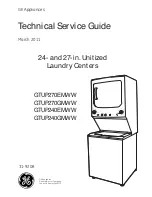
6
cone and the edge of the inlet) is obtained by loosening the
inlet cone bolts and repositioning the inlet cone.
Size
Maximum
Overlap
Size
Maximum
Overlap
100
5/8”
300
1”
120
330
135
365
150
402
165
445
180
490
1-1/4”
195
540
210
3/4”
600
225
660
245
730
270
Wheel/Inlet Overlap
Radial Clearance
Overlap
d. Correctly position the wheel and tighten the bearing
bolts securely to the bearing support.
e. Align setscrews bearing to bearing and secure tightly
to the shaft.
Never tighten both pairs of setscrews before secur-
ing bearing mounting bolts. This may damage the
shaft.
f. Inspect the wheel position again. If necessary, readjust
by loosening the bearing bolts and setscrews and
repeat from step e.
g. Test run the fan.
h. Retighten setscrews on bearings, sheave and wheel.
Recheck belt tension and adjust as needed.
Wheel Replacement
a. Drill two holes approximately centered between the
shaft and the edge of the hub OD with the following
dimensions:
• 1/4” diameter
• 3/8” to 1/2” deep
• 180° apart in face of hub
b. Tap 1/4” holes to 5/16” thread with the 5/16” hole tap.
Do not drill or tap any larger than recommended.
c. Screw the puller arms into the tapped holes full depth
of threads (3/8” to 1/2” approximately). Align center of
puller with center of shaft. Make certain all setscrews
in hub (normally a quantity of two) are fully removed.
Work puller slowly to back wheel off the shaft
Recommended Puller
Lisle No. 45000 Sterling Wheel Puller. This puller is avail-
able at most automotive parts retail outlets.
Wheel-to-Inlet Clearance
The correct wheel-to-inlet clearance is critical to proper
fan performance. This clearance should be verified before
initial start-up since rough handling during shipment could
cause a shift in fan components. Refer to wheel/inlet draw-
ing for correct overlap.
Adjust the overlap by loosening the wheel hub and mov-
ing the wheel along the shaft to obtain the correct value.
A uniform radial gap (space between the edge of the
Wheel Replacement Components
Above
- Drilled hole placement.
Right
- Wheel puller.
Troubleshooting
Problem and Potential Cause
Low Capacity or Pressure
•Incorrect direction of rotation. Make sure the fan rotates in same di-
rection as the arrows on the motor or belt drive assembly.
•Poor fan inlet conditions. There should be a straight clear duct at the
inlet.
•Improper wheel alignment.
Excessive Vibration and Noise
•Damaged or unbalanced wheel.
•Belts too loose; worn or oily belts.
•Speed too high.
•Incorrect direction of rotation. Make sure the fan rotates in same di-
rection as the arrows on the motor or belt drive assembly.
•Bearings need lubrication or replacement.
•Fan surge.
Overheated Motor
•Motor improperly wired.
•Incorrect direction of rotation. Make sure the fan rotates in same di-
rection as the arrows on the motor or belt drive assembly.
•Cooling air diverted or blocked.
•Improper inlet clearance.
•Incorrect fan RPMs.
•Incorrect voltage.
Overheated Bearings
•Improper bearing lubrication
•Excessive belt tension.


























